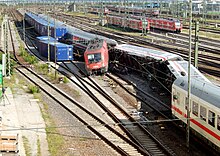Flank run

Flanking is a signaling technology term for the risk of a vehicle colliding with another on the side, driving it “into the flank”. The cause of a flank drive in road traffic is usually the failure to observe the right of way or a traffic light system (coll. "Traffic light"). In the case of rail operations in Germany , the risk of flanking must be ruled out in accordance with the legal requirements of the railway building and operating regulations and the regulations of the Deutsche Bahn based on them, compliance with which is also monitored by the EBA . At higher control speeds, this even has to be technically ensured and proven due to the long braking distances.
In the railway sector, this term is used in the narrower sense when two railway vehicles collide at a point where two tracks meet in a switch or a track crossing . In interlocking technology, driving on a track section in the flank protection area is referred to as flanking in the broader sense - if a (subsequent) flanking cannot be ruled out in the narrower sense.
If the route is unused, the cause can be an incorrectly set switch or an erroneously enabled signal . Routes are protected by side protection devices such as safety switches in a rejecting position, track barriers in place , signals that call for a “stop” (immediate side protection). Where only stop signals are available, special operational protective measures such as a no-run, maneuvering ban, special securing of parked vehicles must be specified in operational documents (indirect flank protection). In modern signal boxes , shunting movements are also largely protected against flanking movements. The crossing of a stop signal in the area of edge protection is usually preceded by disregard of the aforementioned operational protective measure.
When shunting rail vehicles, the boundary sign signals to the railroad workers how far the tracks may be occupied in the case of converging tracks, such as a switch, so that there is no flanking.
For example, a flank trip occurred on September 26, 1908 at Gleisdreieck in Berlin , whereupon one of the railcars fell from the elevated railway. The accident resulted in 18 deaths and 21 seriously injured. The triangle was therefore converted into a tower station in 1912 . On November 4, 1913, a flank journey with at least 40 deaths occurred in the train station of Melun in France , another on October 24, 1919 in Kranowitz, Silesia, with 25 to 60 deaths .
With the further development after the Second World War and the elimination of the most serious war damage, improved signaling and interlocking technology was used to keep rail traffic safe. Nevertheless, even today flanking trips are not completely ruled out.
Individual evidence
- ^ History of the elevated railway station Gleisdreieck 1900–1912 . berliner-verkehrsseiten.de; Retrieved September 12, 2010
- ↑ Heinz Gläser: Dangerous Gleisdreieck - The elevated railway accident of September 26, 1908 . In: Berlin monthly magazine ( Luisenstädtischer Bildungsverein ) . Issue 9, 1999, ISSN 0944-5560 , p. 98-101 ( luise-berlin.de ).
- ↑ Peter Scholz and Klaus Moritz: Train collision in Saalfeld: Over 200 train passengers evacuated. Ostthüringer Zeitung , September 6, 2013, accessed on September 8, 2013 .
